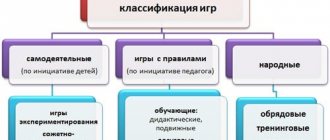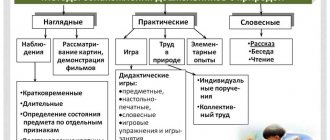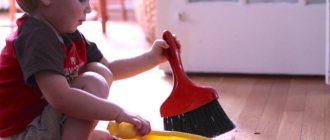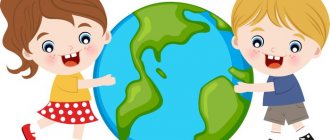Environmental education is an important component of the educational process in schools and kindergartens. Teachers organize their work in this direction both in the process of educational activities and in extracurricular activities. Forms, means and methods of environmental education are selected in accordance with the age of the children, the degree of their interest, and the natural environment.
Methods, forms and means of environmental education depend on the age of the children. The leading form of organizing work on environmental education is a lesson (class in a preschool educational institution). Experiences, experiments, observations, projects, the use of literature, conversations - those are the methods that the teacher uses in direct educational activities. In addition, in extracurricular activities. Extracurricular activities include excursions, holidays, themed leisure, and work with parents. All forms and methods can be used both in combination and separately.
Forms of environmental education
- Lesson . The most basic and most common form of work on environmental education of children is the lesson. He also classes (GCD) in kindergartens. In support of environmental education, such a subject as the surrounding world was created, which introduces children to living and inanimate nature, its laws, and the basics of environmental protection.
Lessons (activities) allow the teacher to develop children's knowledge about nature, taking into account their age characteristics. There are several types of classes:
- Initial informational. Such lessons (lessons) have an introductory function, that is, they introduce children to certain species (animals, birds, fish, etc.), their living conditions, natural phenomena, and basic concepts about the environment. The necessary material for such activities (lessons, conversations) are visual materials (demonstration aids, posters, films);
- Generalizing. Allows children to form general concepts about certain types and natural phenomena, the ability to identify their common features (senior preschool and primary school age);
- In-depth cognitive. Classes (lessons) that are based on previously acquired knowledge. Deepening what has already been learned, applying it in practice - such lessons are conducted in the form of a conversation, a quiz, or watching a video in class.
- Ecological holidays. Activities that are classified as extracurricular activities. They can be either timed to coincide with calendar holidays (Earth Day), or independent, invented by teachers. The purpose of such leisure is to evoke a positive emotional response in children, which in turn awakens interest in environmental problems. When drawing up an entertainment script, material that is already familiar to children is used.
- Excursions . Starting from the middle group of a preschool educational institution and ending with the middle classes of a comprehensive school, an excursion is one of the most effective forms of work on environmental education of children. And this is understandable. No matter how much we talk, no matter how many conversations we have, nature is an environment that can only be experienced by coming into direct contact with it, in a natural setting. The teacher conducts excursions in accordance with the requirements of the state educational program, previously indicating goals and objectives in the calendar plans.
- Labor It would be strange not to indicate this form of direct combination of human activity with environmental protection. In kindergartens, this is caring for living corners, flower beds, small vegetable gardens, organized by educators for the purpose of environmental education of children. At school, this means cleaning the area, watering, caring for plants, and working on the school site (especially common in rural schools).
- Participation in school city competitions and olympiads. Such competitions are often held both by the schools themselves to strengthen motivation among students, and by the city administration. Site reviews, quizzes, olympiads - all this awakens the spirit of competition, and, as a result, provides significant motivation for environmentally oriented detail among children of primary and senior school age.
- Working with parents. A full educational effect is achieved when school and family act in the same direction. Therefore, working with parents is one of the most important forms of environmental education. Consultations for parents, participation in school events, experiments conducted by children together with their parents (at home, in the country, in the village), participation of parents in shows and exhibitions are techniques that are necessary for fruitful work.
Environmental education classes for preschoolers
Forms and methods of environmental education of preschool children in accordance with the Federal State Educational Standard for Education
Forms and methods of environmental education
children of preschool age in accordance with the Federal State Educational Standard of Education
Natalya Vladimirovna Merkulova, teacher of the MDOU TsRR-kindergarten No. 44 “Bell”, Serpukhov
Nature surrounds the child from an early age. A preschool child lives in a specific social, cultural, and natural environment. And the power of nature, its impact on the formation of a child’s personality is well known.
The ability to observe, developed in the process of learning about nature, gives rise to the habit of drawing conclusions and fosters the logic of thought. Children’s ability to compare, contrast, and draw conclusions improves, and a sense of beauty is formed.
In the process of environmental education, children develop cognitive actions, develop cognitive motivation and interest in the natural world, curiosity, creative activity, i.e. those personal qualities of the child that are presented as targets in the Federal State Educational Standard for Education. The goals and objectives of environmental education, as well as the content of the teacher’s work in this direction are reflected in the educational area “Cognitive Development”, sections “Acquaintance with Nature” and “Development of Cognitive Activity” of the Model General Educational Program for Preschool Education “FROM BIRTH TO SCHOOL”, as well as in OOP DOW.
Goals and objectives of environmental education
: Familiarization with nature and natural phenomena. Development of the ability to establish cause-and-effect relationships between natural phenomena. Formation of primary ideas about the natural diversity of planet Earth. Formation of elementary ecological ideas. Forming an understanding that man is part of nature, that he must preserve, protect and protect it, that everything in nature is interconnected, that human life on Earth largely depends on the environment. Developing the ability to behave correctly in nature. Fostering a love for nature and a desire to protect it. Development of children's cognitive interests, development of curiosity and cognitive motivation; formation of cognitive actions, development of imagination and creative activity; the formation of primary ideas about objects of the surrounding world, about the properties and relationships of objects of the surrounding world. Development of perception, attention, memory, observation, ability to analyze, compare, highlight characteristic, essential features of objects and phenomena of the surrounding world; the ability to establish the simplest connections between objects and phenomena, to make the simplest generalizations. A feature of the educational process in accordance with the Federal State Educational Standard is that the processes of education and training do not directly develop the child in themselves, but only when they have activity forms and have appropriate content. One way to improve the effectiveness of environmental development is to use a variety of methods and techniques. The teacher must be able to correctly select educational material and think through the methods and techniques with which he can best convey its content.
1. Basic forms of environmental education:
1.1 Direct educational activities
Classes are the leading form of organizing work to familiarize children with nature. They allow the teacher to form knowledge about nature in a system and sequence, taking into account the age characteristics of children and the natural environment.
There are several types of activities:
Primary orientation type of classes:
Most often, these classes are devoted to introducing children to species of animals, plants, their living conditions and habitats, which are not represented in the immediate natural environment and cannot be known through observation. The main component of such classes are various demonstration and teaching aids, i.e. clarity that allows children to form clear and correct ideas.
Generalizing type of classes
allows, in older preschool age, to form generalized ideas about objects and natural phenomena, identify a number of significant features for a group of familiar objects, compare, juxtapose, analyze, draw conclusions, and develop abstract thinking.
In-depth cognitive type of lesson:
These are classes that are built on a variety of specific knowledge acquired by children during observations in everyday life of natural objects from the immediate environment, and in which the teacher supplements the knowledge with new information and deepens it.
1.2 Excursions
Excursions are one of the main types of activities and a special form of organizing work to familiarize children with nature. The advantage of excursions is that they allow children to become acquainted with objects and natural phenomena in a natural setting. Excursions as a form of classes are conducted starting from the middle group. It is advisable to conduct nature excursions to the same places at different times of the year in order to show children seasonal changes in nature. The teacher plans an excursion based on the requirements of the program and the characteristics of the surrounding area.
1.3 Ecological holidays and leisure activities
The pedagogical meaning of holidays and leisure is to evoke in children a positive emotional response to their “natural” content. The scripts for these events use material that children are familiar with. More often than holidays, leisure activities are held on a variety of topics - they are organized by the teacher.
1.4 Introducing children to nature in everyday life
The teacher introduces the pupils to the daily changes of nature according to the seasons in the kindergarten area, organizes a variety of games with natural materials - sand, clay, ice, leaves, etc. Walks give the children the joy and pleasure of communicating with nature and help them feel its beauty.
In the group, it is necessary to create an appropriate RPPS, which provides for the construction of a variable developmental space, focused on the possibility of children freely choosing materials and participants in joint activities. It should be accessible, that is, provide students with free access to materials, manuals, and natural objects. Safe, i.e. all its elements must meet the requirements for ensuring reliability and safety of their use. And include not only a natural corner, but also a center of cognitive activity for experimenting with various materials, observing natural phenomena and inanimate objects. 1.5.
Labor Interesting and varied work is carried out in the flower garden and vegetable garden. Children observe plants, practice labor skills (watering plants, loosening, collecting seeds and harvests, etc.). This work has a great influence on the development of hard work, independence and mutual assistance. In senior and preparatory school groups, it is possible to organize site duties in the spring and summer or assign groups of children to a garden bed or flower bed. The teacher conducts work and observations in a corner of nature with children every day. The form of organization of activities is different (depending on age). Children, starting from the younger group, are involved in certain work assignments.
1.6
.
Organization of exhibitions and competitions of creative works 1.7.
Participation in children's environmental competitions and Olympiads 2. Methods of environmental education.
In the pedagogical process, various teaching methods are used: visual, practical, verbal. When introducing children to nature, all of these methods are widely used.
Towards visual methods
include observation, examination of paintings, demonstration of models, films, videos, presentations.
Practical methods -
This is a game, elementary experiments and simulation.
Verbal methods
- these are stories from the teacher and children, reading works of art about nature, conversations.
When working to introduce children to nature, it is necessary to use different methods in a complex and correctly combine them with each other. Visual methods
2.1 Surveillance
Observation is a specially organized by the teacher, purposeful, more or less long-term and systematic, active perception by children of objects and natural phenomena. The purpose of observation can be the assimilation of various knowledge - establishing the properties and qualities, structure and external structure of objects, the reasons for the change and development of objects (plants, animals), seasonal phenomena. It allows you to show children nature in natural conditions in all its diversity, in the simplest, clearly presented relationships.
Observation can be carried out both with individual children, with small groups (3-6 people), and with the entire group of pupils. Depending on the goals set by the teacher, observation can be episodic, long-term and final (generalizing). 2.2 Use of illustrative and visual material in working with children
Introducing children to nature, the teacher uses a variety of illustrative and visual materials: didactic paintings, reproductions of artistic paintings, photographs, slides, models, films and videos.
Illustrative and visual material helps to consolidate and clarify children’s ideas obtained through direct perception of natural phenomena. With its help, you can form knowledge about objects and natural phenomena that are impossible to observe at the moment or in a given area (wild or domestic animals of other climatic zones).
Practical methods
2.3 Simulation
Often, on the basis of sensory knowledge, it is necessary to “construct” in the mind an abstract, generalized idea of an object or a whole natural phenomenon, to draw up a diagram of the phenomenon being studied. Modeling helps the teacher successfully solve these problems as a method of introducing children to nature. It is based on the principle of replacing real objects with objects, schematic images, and signs.
2.4 Simple experiments and experimentation
To ensure that children’s knowledge about nature is conscious, simple experiments are used in kindergarten. Experience is an observation that is carried out in specially organized conditions.
Experiments contribute to the formation of children's cognitive interest in nature, develop observation and mental activity. In each experiment, the cause of the observed phenomenon is revealed, children are led to judgments and conclusions.
Experiments are most often carried out in older groups of kindergarten. In the junior and middle groups, the teacher uses only individual search actions.
Experience should always be built on the basis of existing ideas that children received in the process of observation and work. Its task and purpose should be clear to preschoolers. When conducting an experiment, the teacher should not cause harm or damage to plants and animals.
2.5 Introducing children to nature through games
A variety of games are widely used to introduce children to nature. In the practice of preschool education, several groups of games are used:
Didactic games-
games with rules and ready-made content. In the process of didactic games, children clarify, consolidate, and expand their existing ideas about objects and natural phenomena, plants, animals, and lead children to the ability to generalize and classify.
Desktop-printed
games are games like lotto, dominoes, cut and paired pictures. In these games, children’s knowledge about plants, animals, and inanimate natural phenomena is clarified, systematized, and classified.
Word games
- these are games the content of which is a variety of knowledge available to children, and the word itself. They are carried out to consolidate children’s knowledge about the properties and characteristics of certain objects.
Outdoor games of nature history
associated with imitation of the habits of animals, their way of life.
By imitating actions, imitating sounds, children consolidate knowledge; The joy gained during the game helps to deepen interest in nature. Experimental games
make it possible to verify the reliability of physical and natural phenomena and patterns (“Drowning - does not sink”, “Soap bubbles”, “Let’s make solutions”, “Which water is easier to swim in”) In older groups, competitive games can be successfully used
, games - trips. Verbal methods
2.6 Teacher’s story about objects and natural phenomena
During classes, excursions and walks, and in everyday communication with children, the teacher uses stories about nature. The main goal of this method is to create in children an accurate, specific idea of an object or natural phenomenon being observed at the moment or previously seen. The story is also used to inform children about new, unknown facts. The topic of the story is chosen by the teacher taking into account the content of knowledge determined by the kindergarten program. When composing a story, the teacher must take care to include in it not only words known to children, but also new ones that enrich their speech.
2.7 Use of natural history fiction
Fiction about nature has a deep impact on children's feelings. Getting acquainted with their content, children experience the course of events and mentally act in an imaginary situation. This helps to cultivate ethical ideas: love and respect for nature. The requirement for the method of using books, common to all age groups, is a combination of reading with direct observations in nature. After reading works of fiction, a conversation is organized about one or more books read.
2.8 Conversation as a method of introducing children to nature
Depending on the didactic goals, conversations about nature are usually divided into the following types: introductory, heuristic and final. Introductory conversation
helps the teacher gather children’s attention, arouse interest in the upcoming activity, update existing experience in order to establish a connection between previously acquired knowledge and the upcoming excursion, observation, etc.
Heuristic conversation
involves establishing the causes of various natural phenomena using reasoning. Such a conversation is based on the children’s existing knowledge gained during the observation process. It is aimed at deepening knowledge about the relationships that exist in nature, and children independently solving cognitive problems.
Final conversation
used to generalize and systematize children's knowledge about nature, obtained in the process of observations, games, reading works of art, work, etc. The final conversation is organized by the teacher, starting from the middle group.
It is carried out as children accumulate ideas about nature and only if these ideas are mastered by all children. 3. Project method
The project method allows children to gain experience on their own.
Learning takes the form of research, the application of existing knowledge in activities, the results of which are truly interesting to the child. Project activities make preschoolers active participants in the educational process and help them independently master the surrounding reality. By participating in projects, a child develops, learns to find a way out of a difficult situation and becomes more confident in his abilities. Tasks for the development of environmental culture can be realized using such forms and methods as
:
— environmental marathons, quizzes, KVN; - environmental actions, especially together with parents; — drawing up environmental maps and plans for ecological trails;
— environmental exhibitions and expositions;
— creation of environmental museums;
— environmental trainings;
— creation of environmental propaganda teams and “green patrol”; — collecting natural objects; — staging and theatrical performances on environmental topics; — meetings with representatives of professions related to environmental protection; — visiting exhibitions (pets, flower shows); - participation together with parents in holding exhibitions, making feeders and birdhouses with their subsequent placement on the territory of the kindergarten or in the courtyards of houses. 4.
Forms of work with parents on environmental education of preschool children.
The example of parents is of considerable importance in raising children. If parents deal with issues of environmental education, then their children will develop interest, love for nature and respect for it. Therefore, environmental education of children should take place in close cooperation with the child’s family. Jointly organized events not only help to ensure the unity and continuity of the pedagogical process, but also introduce into this process the special positive emotional coloring necessary for the child. When working with parents on environmental education of children, both traditional and non-traditional forms are used, but all these forms are based on the pedagogy of cooperation:
— Questionnaires, conducting surveys
— Round table discussions, parent meetings in a non-traditional form (talk shows, business games, pedagogical services bureau, direct telephone), — Consultations and environmental messages for the parent corner.
— Calendar of interesting dates—joint leisure activities, holidays, KVNs, quizzes, etc.
— Participation in exhibitions, shows and competitions.
— Involving parents in joint work with their children on the site and in the corner of nature.
- Production of newspapers, photo newspapers, environmental albums, posters, folders - travel documents.
Thus
, the formation of environmental consciousness, ecological culture is a long process, the beginning of this path is preschool childhood. The formation of the principles of ecological culture is the formation of a consciously correct attitude directly towards nature itself in all its diversity, towards the people who surround and create it.
And in conclusion, I would like to say that the most important thing in environmental education is the personal conviction of the teacher, the ability to interest and awaken in children and parents the desire to love, cherish and protect nature.
Methods and techniques of environmental education
Environmental education within the framework of the state educational program is an important part of the overall pedagogical process. As in any process, teachers try to use all the methods and techniques of education available to them.
Visual methods
As they say, it’s better to show once than to tell a hundred times, especially when it comes to children and their relationship with nature. In environmental education, visual methods are:
- Observation. It is always planned and purposeful. Observation has an object, a goal, and a time frame. The purpose of observation may be the causes of animal behavior, changes, development of living and inanimate objects, establishing and changing the properties, qualities, structure and appearance of the observed object or phenomenon. Observations can be carried out in small groups or the whole class at the same time, within and outside of educational activities. S.N. Nikolaeva, the author and developer of the system of environmental education in preschool educational institutions, pays great attention to observation as one of the most effective methods in this area of education.
- Illustrative and visual material. Books, illustrations, flashcards, films, videos, photographs and paintings - all this is illustrative material with which the teacher has the opportunity to introduce children to those natural phenomena (objects) that are not available for observation in natural conditions.
Practical methods
Practical methods are necessary to fully integrate children into environmental culture.
- Modeling. The modeling method is well suited for children in primary and secondary school. It represents the replacement of real objects (phenomena) with the help of diagrams, signs, figures or images. Modeling helps children create a general understanding of the object being studied.
- Experiences and experiments. Experience in environmental education is observation of the object being studied in conditions specially created for this. The experience must have a purpose and purpose. The course of the experiment must be thought out, as well as technologies and means. The experience itself is logically completed verbally or in writing.
- Ecological games. Didactic, mobile, board or verbal - a game is an introduction, cognition and consolidation of material. Play, as a method of environmental education, is widely used by kindergarten teachers, since in preschool age play is the leading activity .
Classes on the topic of ecology in 2 junior groups of preschool educational institutions according to the Federal State Educational Standard
Verbal methods
By verbal methods we mean conversations, stories, analysis of what we read or saw. Verbal methods are almost always supported by visual ones. A conversation always precedes any game, experiment, or observation. Conversation accompanies any other method.
One of the verbal methods is reading fiction. This can be either special environmental literature recommended by the curriculum, or works of classical writers. Many authors paid attention to the problems of nature, wildlife, and environmental protection.






